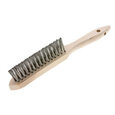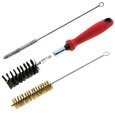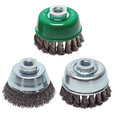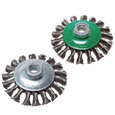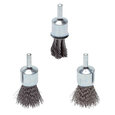Welding Wire Brush
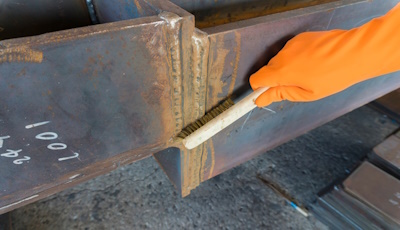
Figure 1: A welding wire brush cleaning up the surface after a welding job.
The primary function of a welding wire brush is to clean the metal surface before and after welding. Before welding, a wire brush removes impurities like rust, paint, mill scale, and other contaminants that can interfere with welding. Additionally, even though dirty surfaces are not the primary cause of weld spatter, clean surfaces can reduce the likelihood that weld spatter will occur.
After welding, a wire brush is suitable for cleaning slag off the weld's surface. Slag is a layer of impurities that forms during the welding process. It comes from the weld flux that protects the weld from atmospheric contamination. However, after the weld, the slag needs to be removed once the weld cools and solidifies. A wire brush can also polish the metal surface, giving it a cleaner appearance.
View our online selection of wire brushes!
Wire brush types for welding
The following wire brushes for welding are all suitable for either part of or the whole welding process. These brushes are either used by hand or attached to a power tool. The benefit of using a hand tool is that it is readily available. The benefit of attaching a brush to a power tool is that it allows for faster and more efficient cleaning.
By hand
- Hand wire brush: A hand wire brush (Figure 2 labeled A) is commonly used due to its simplicity and readiness. It can be used before and after welding for cleaning and polishing work.
- Tube wire brush: A tube wire brush (Figure 2 labeled B) is suitable for cleaning the inside of tubes and pipes before welding.
Attached to a power tool
- Cup wire brush: Cup wire brushes (Figure 2 labeled C) can clean large, flat surfaces. These brushes are typically attached to angle grinders via a threaded connection.
- Wire wheel: Wire wheels (Figure 2 labeled D) are suitable for large surfaces that need cleaning or polishing. These brushes can be used before and after the welding process. Depending on the wire wheel brush's connection point, it can connect to angle grinders, bench grinders, or drills.
- Shank wire brush: Shank wire brushes (Figure 2 labeled D) are ideal for cleaning hard-to-reach surfaces, such as the insides of pipes and tubes, and corners. Shank wire brushes can connect with power drills.

Figure 2: Wire brushes used in welding tasks: hand wire brush (A), tube wire brush (B), cup wire brush (C), wire wheel (D), and shank wire brush (E).
Brush material
The bristles of a wire brush come in various materials. It's essential to choose the suitable brush material for a specific metal surface:
- Stainless steel: Stainless steel wire brushes for welding are suitable for stainless steel and aluminum surfaces. These bristles excel at cleaning off impurities and polishing surfaces. If working with stainless steel and aluminum materials, have one brush for each. Cross-contamination between the two can cause impurities and degradation.
- Bronze and brass: Bronze and brass bristles are suitable for softer materials like copper and brass.
- Nylon: Nylon bristles are ideal for light tasks, such as cleaning off dust and light rust. They can also polish the material surface after welding, but they are less effective than stainless steel and bronze. Do not use a nylon-bristled brush on a hot surface.
How to use a wire brush
Using welding brushes before and after welding is straightforward. The brush is used to scrub the surface until all visible impurities are removed. It's necessary to scrub in the direction of the metal's grain for better results.
Before the weld
- Safety: Wear the necessary PPE (personal protective equipment). This includes gloves, safety glasses, and a dust mask to prevent inhalation of particles.
- Choose the correct brush: A stainless steel brush is ideal for heavy rust or scale. A brass brush may be more appropriate for lighter work or more delicate surfaces.
- Apply brush to surface: Use firm, even strokes to scrub away any rust or other contaminants. Clean the surrounding area as well to ensure a successful weld.
- Wipe area: After brushing, wipe the area with a clean rag to remove any loose particles.
After the weld
- Allow the weld to cool: Do not brush a hot weld because it can damage the brush and cause injury.
- Remove slag and spatter: Use firm, even strokes to remove any slag or spatter.
- Wipe area: Again, clean the area with a rag to remove loose particles and have a clean, finished weld.
FAQs
Why is a stainless steel wire brush used in welding?
A stainless steel wire brush is used because it helps prevent contamination that could lead to rusting. It's ideal for use on stainless steel and aluminum.
How often should I replace my welding wire brush?
The lifespan of a wire brush depends on its usage. Once the bristles start wearing out and are no longer effective, it's time to replace the brush.
Can I use a wire brush on all types of metals?
No, different wire brushes are used for different metals. For instance, a brass brush is used for softer metals like copper or brass, while a carbon steel brush is used for heavy-duty cleaning.




